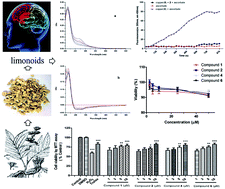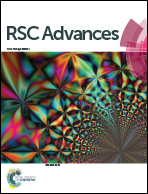Limonoids from the root bark of Dictamnus angustifolius: potent neuroprotective agents with biometal chelation and halting copper redox cycling properties†
Abstract
Six novel limonoids, dictangustones A–F (1–6), along with four known limonoids were isolated from the root bark of Dictamnus angustifolius. The structures of the new limonoids were established by extensive 1D and 2D NMR spectroscopic experiments. In vitro studies show that all limonoids exhibited metal chelating property. Moreover, the Cu–ascorbate redox system assay revealed that the selected limonoid 2 could control Cu(I/II)-triggered hydroxyl radical (OH˙) production by halting copper redox cycling via metal complexation. Importantly, the selected limonoids 1, 2, 4 and 6 were nontoxicity to SH-SY5Y cells and showed significant neuroprotective activity against neuronal death induced by oxidative stress. Taken together, these limonoids such as limonoid 2 may be good candidates for developing new drugs in the treatment of neurodegenerative diseases, such as Alzheimer's disease and Parkinson's disease.


 Please wait while we load your content...
Please wait while we load your content...